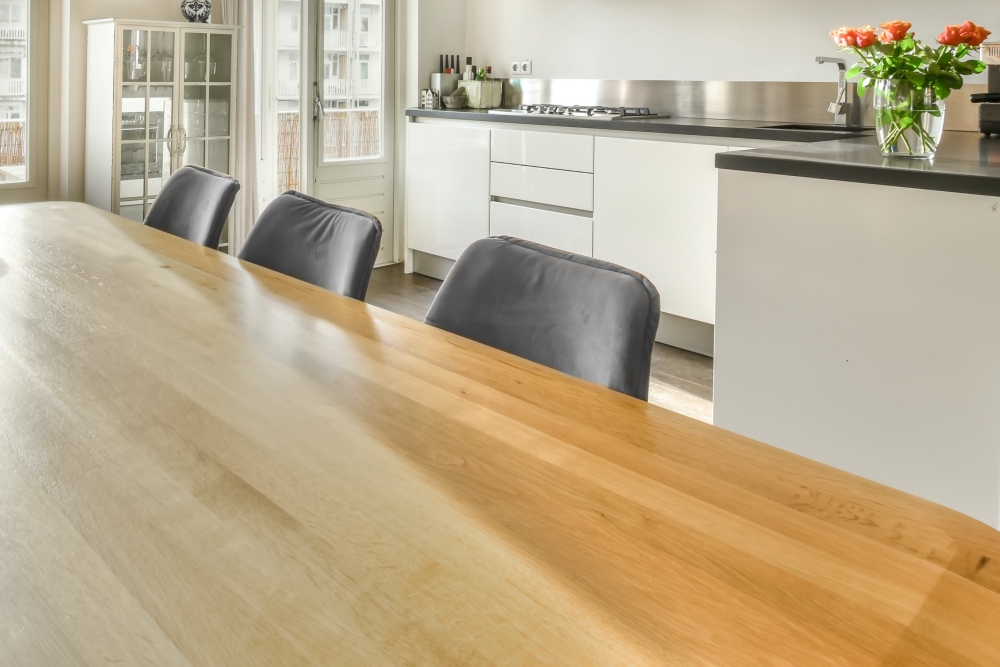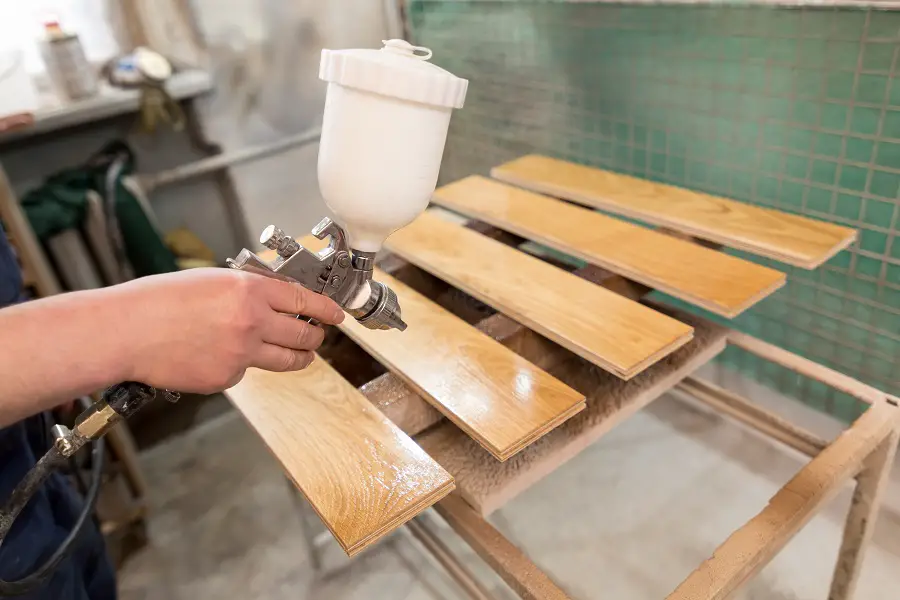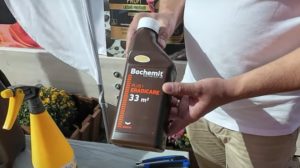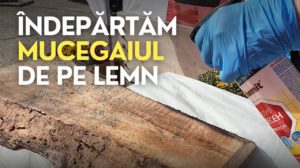For many wood enthusiasts and even very good carpenters, wood finishing is not their forte. Therefore, I choose to give more elaborate explanations, hoping to be of use to those eager to know as much as possible about coloring and protecting the wood surface. Here I will present the solution to obtain a smooth "glass-like" surface, through which the wood's design can be clearly seen. I should point out at the outset that I will not be referring to epoxy resin coating, which you can find out more about here here and here. It will be about finishing the wood used on the interior because, as explained, on the outside, semi-transparent or opaque products are required for a durable finish.

To achieve that perfect surface there are several aspects to pay attention to
There is no miracle material that you can apply to wood and get the glass surface. The result is obtained by using quality materials, suitable for the final purpose, respecting all the work steps, sanding the surface well and working in the cleanest, dust-free environment possible. Each of these elements has its importance and one without the other is not possible.
Such a finish is not simple to do. To achieve a stained wood with a 'glass' finish, there are several things to consider:
- Colouring. You should use a material that does not cover the wood design but highlights it.
- Polishing. It is important both to sand the wood to get a uniform color and to sand between coats to get that glass-like smoothness. If you also want the surface to be glossy, you will most likely need to polish it at the end.
- Materials. Primer, varnish and number of coats applied. The transparency, depth and smoothness of the film depend on them.
- Application. How to apply materials
- Working environment.
Being a difficult finish it is much easier to achieve in factory conditions. There, the machinery used to apply the materials is professional and high-performance, and the workspace is suitable for achieving a smooth surface and a good, glass-like gloss. If we're talking about a DIY project, it's more difficult to achieve a perfect surface in terms of transparency. The varnishes in DIY stores don't usually have the necessary clarity, and brushing or tracing isn't the best way to get a film with depth. But it's not impossible if you choose your products carefully and give the application extra time and attention.
Pay attention to the materials used
Colouring is made with transparent baths. What does this mean? They are baths made with colorants that dissolve, not pigments. Colorants that dissolve in water or solvent make clear solutions. They absorb into the wood and color it without coating it. The advantage of such solutions is that they bring out the design of the wood. The disadvantage, for those who like a uniform look, is that they also highlight surface imperfections and do not hide any defects in the wood. In the end, the colored wood will be perfectly visible, but the appearance will not be uniform except in rare cases, when the wood does not absorb very differently and has a uniform pattern. Stains containing pigments are not clear because the pigments do not dissolve, forming dispersions. Applied on the surface, they will partially cover the wood. The coloration will be more uniform but semi-transparent.
Grundul is necessary to get that smooth surface on which the lake is finally laid. As with mirror gloss finishIn order for the varnish to spread well and obtain a glass-smooth surface, you need a material that can be sanded well. Sanding removes any imperfections in the film - air or dust trapped in the film, the orange-peel appearance - and gives a smooth, even surface. The primer must also have good transparency. This means a highly filtered product and no fillers, which makes it more expensive than other primers.
Lake must be transparent, hard and as glossy as possible. Mat varnishes contain matting agents that spoil transparency and clarity. The hardness of the varnish also contributes to its glass-like appearance. In the past, polyester lacquers were used to achieve these glass-like surfaces. They were very hard, transparent and full-bodied so the finish had depth. For comparison, if you were using nitrocellulose varnish you needed 10-15 coats, as opposed to the 3-4 coats that the polyester system was all about. Now the most beautiful "glass" surfaces are achieved with polyurethane lacquers.
Sanding is important at all stages: coloring, priming and varnishing.
Coloring, wood sanding is important because it ensures uniform absorption of the stain into the wood. It is sanded with wood-specific sanding paper with a final grain size of 150, 180, even 220 if the wood is loose and loose. At lower grits, the absorption of the wood stain into the wood will be higher and more difficult to control, and when the paper is finer, the fine dust formed prevents the color from penetrating into the wood, resulting in stains and very light coloration. After drying, the wood will not sand, even if the wood grain has risen. Sanding to remove the raised grain is done after the first coat of primer in order not to spoil the appearance of the stained wood.
The primer is sanded to ensure adhesion between coats and to achieve that smooth surface mentioned above. Sanding is done with finer paper, min 400 grit for glossy finishes. Grits of 280 or 320, frequently used for sanding primer, are not recommended for very transparent and glossy varnishes because there is a risk that the fine grains created by sanding will be visible. Information on how to choose sanding materials depending on what you are sanding can be found at here. Apply at least 2 coats of primer, but up to 4 coats can be applied to ensure film depth. The smoothest surface is obtained by sanding the primer after each coat. After sanding, the surface should be sanded down as the remaining dust can ruin transparency and adhesion between coats.
If the lacquer film has an orange-peel appearance, it needs to be polished to achieve a smooth, glass-like appearance. The same is true if the working medium has a lot of dust trapped in the film. For good results, polishing should be done in steps, starting with 600, 800 grit fine sandpaper and working up to 1000, 2000, 3000 and finer grit abrasive pastes.
Find information about polishing here.

Working steps, step by step
Because the most beautiful surfaces are obtained with polyurethane varnishes, the following steps are for polyurethanes. But other varnishes - acrylic, waterborne, nitrocellulose - can also be used - the sequence of operations is the same. Here are the steps:
- Wood sanding, air blasting and wiping with a cloth.
- Applying the bath. A more even surface can be achieved by applying the excess polish and then wiping with a clean cotton cloth. This method is recommended for water-based wood stains and is also a way to emphasize the natural wood grain. There are techniques to even out by spraying solvent-based stains, but unfortunately they hide the wood's design.
- Drying the berry. Solvent-based varnishes dry faster than water-based. For the latter a minimum of 8 hours is recommended. It is best to observe the time recommended by the bath manufacturer. When dry, the appearance of the wood becomes dull, slightly grayish, without the brightness it has when wet.
- Primer application. Apply min. 2 coats of primer with drying and sanding between coats. The quantity applied should be approx. 100-120 g/m². If the resulting surface has had many defects, and to remove them it was necessary to sand the primer coat vigorously, removing a good part of it, apply at least one more coat to obtain the required depth. The drying time is that recommended by the manufacturer. Polyurethane products generally require catalyzing. The type of catalyst and proportions are determined by the manufacturer. Changing the catalyst may result in variations in drying time and hardness of the primer. Use the thinner recommended by the manufacturer. Use of a fast thinner to hasten drying may result in gassing of the film. To remove roughness the surface must be thoroughly sanded.
- Varnish application. Gloss and clear lacquers are more sensitive and must be applied exactly as the manufacturer says, without changing the catalyst, thinner or mixing ratios. These changes may result in changes in gloss or transparency. In general, a single coat of varnish is applied at about 120-140 g/m². For more depth it may be necessary to apply an additional coat of varnish. Ideally, the 2 coats should be applied 1-2 hours apart so that sanding between coats is not necessary. If more than 6-8 hours have elapsed, allow the varnish to dry completely and then sand. Then apply the next coat. Gloss lacquers need a longer drying time. The manufacturer's recommendation is the one to follow in this case too.
- Polishing the lake. It is done only after it is completely dry. For good results it must be done in stages. Polishing is not always necessary. If there is not much dust in the working environment, the exhaustion is good and there is a special space where the varnish is applied, the result obtained after drying can be satisfactory. Especially if the varnish does not have that very high, mirror-like gloss.
I hope you find the above information interesting. If you are used to getting such smooth, hard, deep, glass-like surfaces, please share your experience. Advice is always welcome. And if you have any questions or queries, leave them below in the dedicated space. I'll be sure to reply.




































Good evening, I would like to ask you which bath best highlights the beauty of the Palin wood! I mention that I have tried water-based and solvent-based baths but the results are modest and stains appear. The same bath from Kemicals works without problems on other woods! Thank you!
Hello!
In my opinion, glazes are best suited for staining paltin.
The beauty of the palindromes comes from the defects - curly or wavy grain, knots - and from the medullary rays that give those specific mirrors that absorb almost no bath. All this leads to irregular absorption in the wood, with very large differences. There are people who appreciate precisely these differences.
If we want uniform staining, we need solutions that absorb the least into the wood. In this case, quick-drying solvent-based stains (high acetone content), first coat staining or glazes (special stains with wipe-off) can be used. Glazes contain resin that regulates absorption and by wiping it off the design is highlighted without staining the surface.